They say… 
Best beer and travel writing award 2015, 2011 -- British Guild of Beer Writers Awards
Accredited Beer Sommelier
Writer of "Probably the best book about beer in London" - Londonist
"A necessity if you're a beer geek travelling to London town" - Beer Advocate
"A joy to read" - Roger Protz
"Very authoritative" - Tim Webb.
"One of the top beer writers in the UK" - Mark Dredge.
"A beer guru" - Popbitch.

|
 Red Lion, Parliament Street, London SW1. Pic: Fuller’s. Westminster, Victoria and Pimlico
Traditional pub (Fuller’s) Regional heritage pub
48 Parliament Street SW1A 2NH
T 020 7930 5826 w redlionwestminster.co.uk
Open 1000-2300 (2100 Sun). Children welcome until early evening.
Cask beer 5 (Fuller’s) CM, Other beer 1 keg, 5 bottles (Fuller’s), Also 17 wines, 12 whiskies.
Food Simple pub lunches, upmarket pub grub, Outdoor Tables on street, Wifi.
Mon comedy, monthly quiz, live music, functions.
Though the engraved glass claims allegiance to now defunct London brewery Taylor Walker, this old fashioned pub in the heart of Westminster’s government district has been a Fuller’s house since 2009 and is a good place to sample the Chiswick brewer’s beers in good condition within easy reach of several iconic sites. The slightly uncommon Chiswick Bitter is a constant alongside London Pride and Seafarers, with seasonals and specials like US influenced Wild River and Bengal Lancer among the bottles.
The interior of this long and narrow corner pub, all deep red and optimised for vertical drinking, is not as spectacular as the nearby St Stephens (p117) but still preserves Victorian features from a fin de siècle rebuild, including columns, glazed screens and a carved Renaissance-style bar back helpfully bearing the date 1900. There’s also a cellar bar and an upstairs restaurant with a slightly more sophisticated menu.
Pub trivia. As suggested by the location and the muted TV screening the Parliament Channel, the Red Lion is popular with parliamentary staff and a few politicians, with its own division bell. It’s also the closest pub to Downing Street, and once boasted it was the favoured drinking den of prime ministers, though the last one known to have drunk here was Edward Heath back in the 1970s. We doubt it’s changed much since.
Underground River Westminster Cycling LCN+ 6A, link to NCN 4 Walking Thames Path, link to Jubilee Greenway, Jubilee Walkway
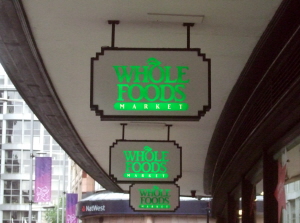 Whole Foods Market Kensington, London W8 London’s Best Beer, Pubs and Bars updates
Central London: Kensington, Chelsea and Earls Court
Shop (Whole Foods Market)
63-97 Kensington High Street W8 5SE
T 020 7368 4500 w wholefoodsmarket.com/stores/kensington f WholeFoodsKensington tw WFM_Kensington
Open 0800 (1100 Sun)-2200 (1800 Sun). Children welcome.
Cask beer 1 (Redemption or local), Other beer 2 keg, 110 bottles, Also Wines.
Food Cheese, charcuterie and snacks, specialist groceries, food court elsewhere in store. Disabled toilet.
In the US, the numerous stores belonging to this Austin, Texas-based, green minded (and union hostile) supermarket chain are usually reliable sources of well priced craft beer, often from local producers. When the huge flagship London branch first opened in the prime site of the former Barkers department store in 2007, the beer choice was disappointing but clearly the management took note of the changing market and in 2011 it was expanded significantly.
Confusingly, it’s not all in one place. On the ground floor you can help yourself to a handful of draught beers in takeaway containers, including a London cask beer on handpump and changing kegs from Meantime or US brewers. Nearby is a chiller cabinet with a small selection of bottles, and a wine tasting bar where four changing bottled beers add variety alongside various snack plates.
In the basement is a much bigger selection of bottled beers, mainly better known brands but all solid stuff and at near-supermarket prices. There’s a good choice of Kernel and Meantime beers plus Anchor, BrewDog, Brooklyn, Flying Dog, Goose Island, St Peter’s, Schlenkerla, Schneider and the like. The odd more unusual supplier like Stroud from the UK or Fordham from the US might pop up too. Elsewhere is a vast range of specialist, deli and organic food and other groceries and an eclectic and keenly priced first floor food court in what has been described as “a Disney World of food”.
Underground High Street Kensington Cycling LCN+ 45, Walking Link to Jubilee Greenway, Princess Diana Memorial Walk
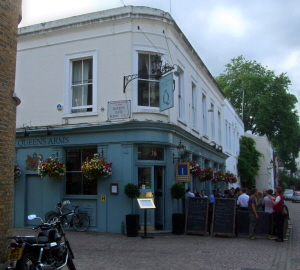 The Queens Arms, London SW7 London’s Best Beer, Pubs and Bars updates
Central London: Kensington, Chelsea and Earls Court
Contemporary pub (Castle/M&B)
30 Queens Gate Mews SW7 5QL
T 020 7823 9293 w www.thequeensarmskensington.co.uk
Open 1200-2300 (2230 Sun). Children welcome until 1900.
Cask beer 8 (Fuller’s, Sharp’s, 6 often unusual guests) Cask Marque, Other beer 6 keg, 5 bottles, Also 2 real ciders, 27 wines, a few specialist spirits.
Food Upmarket pub grub/gastro, Outdoor Standing area on mews, Wifi. Disabled toilet.
Occasional big screen sport.
Tucked away in an achingly picturesque cobbled mews only a short step from the Albert Hall, Hyde Park and the Kensington museums, this friendly and cheerful pub with its distinctive rounded entrance, cream coloured walls and old wood panelling fits in perfectly with its surroundings. This is a seriously desirable part of town but not all the regulars are well heeled locals – students from Imperial College, concertgoers and more adventurous tourists pop by to enjoy an excellent lineup of cask ales that might include choices from Ilkley, Hawkshead, Kelham Island or Purity besides regulars London Pride and Doom Bar. Budweiser Budvar, Franziskaner wheat beer and Meantime London Pale are among the keg choices with Duvel and Worthington White Shield in bottles. One of the better pubs in a generally reliable chain.
Underground Gloucester Road, South Kensington, High Street Kensington Cycling LCN+ 45 Walking Link to Jubilee Greenway, Princess Diana Memorial Walk
 Holborn Whippet, London WC1 London’s Best Beer, Pubs and Bars updates
Central London: Holborn and Legal London
Bar, specialist (Euston Tap)
25-29 Sicilian Avenue WC1A 2QH
T 020 3137 9937 w holbornwhippet.com f HolbornWhippet tw holbornwhippet
Open 1200-2300 (2330 Thu-Fri, closed Sun though may change in future). Children welcome until early evening.
Cask beer 6 (often local or unusual guests), Other beer 10 keg, Also Some wines and specialist spirits.
Food Short burger and steak menu, Outdoor Some tables on street, Wifi.
Table football, functions and parties.
The owners of the Euston Tap expanded to this more central location in June 2012. While not as characterful as the Tap’s repurposed gatehouse, the site has its interest: it’s on Sicilian Avenue, a short, elegant and well preserved Italian-inspired pedestrianised shopping street of a type unusual in London, developed in 1910 and still something of a pleasant surprise in businesslike Holborn.
The Whippet presides over two conjoined units at one end of the street. Indoors is breezily but stylishly minimalist, with a bar area centred on a brick pillar from which cask and keg taps sprout, and an adjacent area with high tables. There’s also a small cellar bar available for private hire. Although more generously proportioned than the Tap, it’s still a squeeze, particularly as it’s regularly busy.
What packs them in is the range of beers from independent producers served by very knowledgeable staff in attractive surroundings. Aside from Bitburger as the house lager, all the lines rotate, with adventurous British brewers like Arbor, Bristol, Camden Town, Dark Star, Magic Rock, Oldershaw, Redemption and Thornbridge represented across both cask and keg taps.
Other kegs might come from the Czech Republic (Bernard), Belgium (Duvel), Germany (Hof, König, Weihenstephaner) or the USA (Dogfish Head, Sierra Nevada, Stone). There’s no room for a bottle fridge, and cask purists suspicious of the unusual dispensing arrangements will be reassured to know that air and not gas pressure is used.
Underground Holborn Cycling LCN+ 6 39 Walking Jubilee Walkway
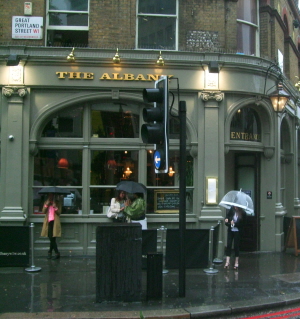 Albany, London W1 Fitzrovia
Contemporary pub (Castle/M&B)
240 Great Portland Street W1W 5QU
T 020 7387 0221 w www.thealbanyw1w.co.uk f thealbanyw1w
Open 1200-2400 (2230 Sun). Children welcome until early evening.
Cask beer 5 (Adnam’s, Sambrook’s, Sharp’s, 2 unusual guests) Cask Marque, Other beer 7 keg, 12 bottles, Also 35 wines, some specialist rums and whiskies.
Food Upmarket pub grub, Outdoor Standing area on street, Wifi. Disabled toilet.
Live music, comedy, DJ nights, occasional big screen sport, functions.
The growing interest of big pub owning companies like Mitchells and Butlers in specialist beer is a sure sign of how the market is growing, and the Albany, part of the group’s unbranded Castle chain, makes more than most of offering a good “craft beer” range. Besides the ubiquitous Doom Bar and other regulars Broadside and Wandle, the two guest cask handpumps are usually given over to contemporary minded small brewers like Hopdaemon, Ilkley, Rooster’s and Sunny Republic.
There’s a rotating Sierra Nevada keg tap – not just the revered but often seen pale ale – besides the likes of Bernard Dark, Camden Town Hells and Meantime London Pale, and worthwhile Belgian stuff like Bosteels Tripel Karmaliet in the fridge besides Worthington White Shield and bottles from Flying Dog and Goose Island.
The sizeable and often busy corner pub right by Great Portland Street Tube is now a single open space with a split level floor, a vintage textured ceiling and cream painted pillars well lit by big arched windows. A generally lively and youthful crowd with a good gender mix occupies its eccentric mix of furniture. Popular DJ and performance nights take place in the cellar.
National Rail Euston Underground Great Portland Street, Regents Park Cycling Links to LCN+ 0 50 Walking Link to Regents Park Path
 Bar Boulud, London SW1 London’s Best Beer, Pubs and Bars updates
Central London: Kensington, Chelsea and Earls Court
Restaurant, bar (Boulud)
66 Knightsbridge SW1X 7LA
T 020 7201 3899 w www.barboulud.com
Open 1200-0100 (2400 Sun). Children welcome until early evening.
Cask beer None, Other beer 8 keg, 6 bottles, Also Cocktails, specialist spirits, wines.
Food Charcuterie, cheese, French & US comfort food. Disabled toilet.
Tastings, bridge society.
Hopefully it will soon no longer be unusual to find great beer wherever quality drinks are sold, but as things stand the swish upmarket bar with a fine beer list remains a rarity. So it’s pleasantly surprising to find a decent range of beer options among the cocktails and fine wines in a corner of the Mandarin Oriental Hotel, just down the road from Harrods, especially since the bar was created by a Frenchman. But then Daniel Boulud also has a similarly named joint in New York City, where craft beer has a more prestigious image, and he’s clearly got good taste.
Smartly dressed head bartender Fabio is as enthusiastic about the beers dispensed from the shining zinc counter top as you’d expect the landlord of a good real ale pub to be – they include decent British lager Cotswold, BrewDog Punk IPA, Harviestoun Bitter & Twisted and classic Bavarian wheat beer Schneider Weisse on tap, plus choices from London’s Redchurch brewery and Harviestoun’s cask aged Ola Dubh in bottle.
The beers are attracting increasing attention so the list may well grow further. Expect to pay at least double pub prices, however, to enjoy them in a stylish and relaxed bistro-style environment with attentive staff and a mix of seating creating numerous attractive spaces. Non-dining drinkers are welcome at the bar, though the simple, high quality food is better value than you might expect, with a reasonable three course prix fixe deal and tempting tasting plates of gourmet cheese and charcuterie from the UK, France and Italy. Note there’s a smart casual dress code.
Underground Knightsbridge Cycling LCN+5, Hyde Park paths Walking Jubilee Greenway, Princess Diana Memorial Walk
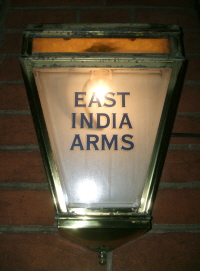 East India Arms, London EC3 London’s Best Beer, Pubs and Bars updates
Central London: Aldgate
Traditional pub (Shepherd Neame)
67 Fenchurch Street EC3M 4BR
T 020 7265 5121 w www.eastindiaarms.co.uk
Open 1130-2100 (Closed Sat-Sun).
Cask beer 4 (Shepherd Neame) Cask Marque.
Food None, though customers welcome to bring in from local takeaways, Outdoor Table and sheltered standing room on street, Wifi.
This modest but attractive and very friendly little pub close by Fenchurch Street station is one of London’s better options for sampling Shepherd Neame cask ales, with Bishop’s Finger, Kent’s Best, Master Brew and Spitfire all regularly available in a consistent condition that’s earned it a Good Beer Guide listing. The current corner building dates from 1839 but the pub claims a history back to 1630.
Indoors is a small single space still furnished in traditional woody style with floorboards and engraved windows and mainly dedicated to standing room and high stools which are enthusiastically occupied by what’s largely a city boy clientele. Worth knowing about.
Pub trivia. The pub was renamed relatively recently after the British East India Company which ruled and ruthlessly exploited the Indian subcontinent for over a century from 1757-1858. The Company played a role in the emergence of India Pale Ale, originally developed as an export style to quench the thirsts of its workers and their families. It’s a shame the pub doesn’t stock a modern example.
National Rail Fenchurch Street Underground Aldgate, Tower Hill DLR Tower Gateway River Tower Cycling LCN+ 11 13, links to NCN 13 CS 3 Walking Link to Jubilee Walkway, Thames Path
European Beer Bloggers Conference 2012
ABV: 7%
Origin: Alloa, Clackmannanshire, Scotland
Website: www.williamsbrosbrew.com
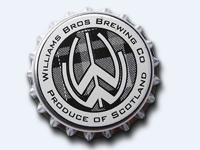 Williams Brothers Brewery Alloa is the largest town in Clackmannanshire, central Scotland – once the smallest Scottish county in the days when the country still had them. A hundred years ago the town ranked alongside Burton upon Trent, Edinburgh, London and Tadcaster as one of the most important brewing centres in Britain but now boasts only a single brewery. It’s doubtful that the brewing dynasties of old would recognise much in the way things are done at Williams Brothers, who have become the last keepers of Alloa’s brewing flame through a very circuitous route.
When the Campaign for Real Ale (CAMRA) was founded in 1971, Maclay’s Thistle Brewery in Alloa was one of only four independent family brewers left in Scotland, and the only one north of the river Forth (the other surviving brewery in the town was by then owned by Allied, one of the ‘Big Six’, and was finally closed by Carslberg in 1998). The Thistle dated from 1870, but the Maclay family had previously brewed since 1830 at the nearby Mills brewery, established around 1804.
In 1999, Maclay became yet another old established British brewery turning its back on the tradition of vertical integration, closing down its brewing operations and converting itself into a pubco, in which form it survives today. Following the closure, former head brewer Duncan Kellock set up the Forth Brewery, a much smaller modern micro at Kelliebank to the southwest of the town, close to the river. Originally Forth had a contract to continue to brew Maclay branded beers, but also brewed for other commissioners – including an up and coming little business known as Heather Ales which was pioneering a new way of creating and marketing Scottish beer.
The Heather Ales story starts in Glasgow, on the other side of central Scotland’s watershed. Founder Bruce Williams ran a homebrew shop in the city where in 1988, so the story goes, he encountered a customer who had inherited from her Highland ancestors a recipe, originally written in Gaelic, for leann fraoch or heather ale. Intrigued, Bruce developed a contemporary version of the beer, which was first sold as Fraoch in 1992, brewed under contract at the tiny, and now closed, West Highland brewery at Taynuilt, Argyll and Bute.
Heather Ales was set up by Bruce and his brother Scott to market this beer and a growing range of other specialities made from unusual Scottish ingredients. The venture proved a great success – with their consistent quality, unusual flavours, attractive labels and national heritage appeal, Heather Ales were an early example of beers that reached out to an audience far beyond the traditional cask ale drinker, and were largely sold as bottled products, including through supermarkets and international exporters. Demand rapidly outstripped capacity and by 1993 the beers were being contract brewed at Maclay.
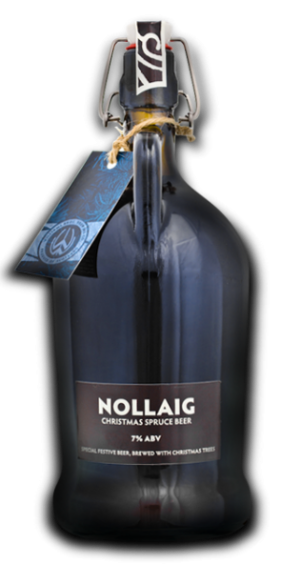 Williams Brothers Nollaig In 1995 the brothers established their own brewery at Craigmill, South Lanarkshire, but this only ever brewed cask beers, with bottled production still at Alloa. When Maclay closed, Duncan Kellock invited Bruce and Scott to invest in his Forth brewery project, and production of bottled Heather Ales relocated there. Then in 2003, with Maclay no longer commissioning its own beers, the brothers took over Forth wholesale and renamed it Williams Brothers, eventually bringing all the brewing in house at Alloa. As well as its own brands, the Alloa site is still used for contract bottling beers from several other Scottish breweries, including Fyne, Inveralmond and Traditional Scottish Ales.
I was always a little disappointed that Williams Brothers shied away from bottle conditioning its beers – the regular bottled products are filtered and usually pasteurised too. I asked Bruce about this several years back and he insisted this was to ensure the beers were consistent for their extensive bottled trade, but he did say they’d considered doing the occasional bottle conditioned speciality. It’s only very recently they’ve taken that step.
Nollaig – named with the Gaelic word for Christmas – was first launched late in 2011 as a limited edition bottle conditioned seasonal special packaged in an attractive bulbous growler-style litre bottle with a swing stopper. You’ll be lucky now to track down the original vintage as only 800 bottles were produced, but it may well be revived again this year. In line with the brewery’s long established penchant for unusual Highland flavourings, it’s enlivened with spruce tips, as well as Amarillo and Centennial hops.
A sample tasted at the 2012 European Beer Bloggers Conference was a rich amber, with a definite spruce note alongside apricots and peaches on a spicy, fruity aroma. An unusual and rather sweet palate had lightly resinous and oily spruce alongside more fruit, pepper, nuts and pastry. Hops came to the fore in a drying finish that became lightly bitter, pursing and herbal, with that rich fruitiness persisting. The flavours were seasonally appropriate without trying to do an impression of a Christmas pudding, and I really enjoyed it, though the sweetness and the hint of conifer wouldn’t be to everyone’s taste.
The Craigmill brewery, incidentally, now operates under new ownership as Strathaven Ales, having been finally sold by Williams Brothers in 2005. And Maclay still just clings on as a beer brand thanks to the Clockwork brewpub, now owned by the pubco, which every so often serves up a version of the defunct brewery’s Oat Malt Stout. It’s been a long way down from a big Victorian factory to a five barrel (8hl) brewpub kit, though there’s a satisfying circularity in the fact that the pub itself is not in Alloa, but Glasgow, where Heather Ales began.
European Beer Bloggers Conference 2012
ABV: 7.4%, 9.2% and 10.5%
Origin: Huddersfield, Kirklees, England
Website: www.magicrockbrewing.com
 Welcome to the beer circus: poster at Magic Rock brewery, Huddersfield. The last few years have seen not just the relentless growth of microbrewing in the UK but also the emergence of new approaches that challenge the old business model of the traditional cask ale market. A broad movement is emerging that cultivates an image and approach more attuned to the tastes of the growing numbers of younger drinkers developing an interest in specialist beer, and is much more open to international influences – particularly from the US in terms of both the beers themselves and the way they’re marketed. Some people tag the representatives of this trend as “craft breweries” and though I think this is an unhelpfully narrow use of the term (see why here), I know what they mean when they say it.
Magic Rock has rapidly established a place for itself in the forefront of this new wave in little over a year. It was founded in March 2011 by businessmen and beer lovers Richard and Jonny Burhouse, the former with previous form in the specialist beer world through his involvement with online retailer myBrewerytap.com. They brought in brewer Stuart Ross from the Crown brewery in Sheffield brewpub the Hillsborough Hotel, whose CV also includes a stint at Kelham Island – thereby placing Magic Rock among the branches of that intertwined family tree that links back to the influence of brewer, licensee and British beer legend Dave Wickett, who died earlier this year.
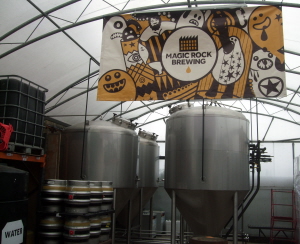 Fermentation tanks at Magic Rock, Huddersfield. From the start the men behind Magic Rock were upfront about their transatlantic aspirations. “The intention is to brew modern flavour-forward beers inspired in part by US craft breweries,” said Rich early in 2011. In this they’re not alone but they’ve certainly caught the style more accurately than most British brewers and managed to bring in their own character too.
I was struck by this when the brewery sent me some sample bottles last autumn, nicely presented in 330ml size and labelled with very distinctive and elaborate pen drawings depicting the brewery’s chosen circus themes. I particularly singled out Cannonball as a well balanced example of a contemporary US-influenced India Pale Ale. It’s brewed with pale, pale crystal and Vienna malts and a trio of US hops – Centennial and Columbus in the boil, Citra in the hop back and more Centennial as a dry hop during conditioning.
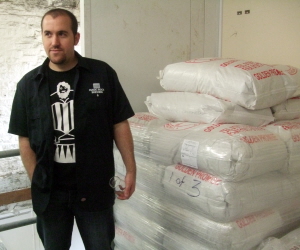 Stuart Ross, head brewer at Magic Rock. It’s a deep gold beer with an off-white creamy head and a creamy and spicy but rounded hop aroma. Estery notes indicate something of its 7.4% ABV, and there’s also a hint of ginger in the nose. The palate is packed with bitter marmalade, pine and almonds, warming into a peach fruit finish with a very light touch of roast in the flavour. The hops leave an assertively resinous, slightly vegetal slick but are nicely rounded by the fruit.
Following this promising encounter I seized the opportunity to visit the brewery during the European Beer Bloggers Conference in May 2012. Arriving at the rather plain industrial buildings in an unexceptional suburb of Huddersfield, the origin of the brewery’s name is immediately obvious – it adjoins the Burhouses’ existing family business trading in crystals, gemstones and decorative rocks. Bins in the yard at the front sparkle with polished pebbles and crystals in a rainbow of colours, destined for home and business decoration, jewellery and new age vibe channelling.
 Magic Rock rocks! Baskets of decorative minerals in the yard outside the brewery. Inside, spread across two floors, is a fairly standard brewhouse from Malrex of Burton upon Trent, originally around 20hl (12 barrels) although the size of the vessels has since been increased to accommodate 26hl (16 barrels). Fermentation capacity has also multiplied since opening, with several outdoor cylindroconical tanks now supplementing the original pair of indoor ones.
The main grist suppliers are Yorkshire maltsters Fawcett, supplemented by speciality producers Weyermann in Franconia. The brewery runs a single infusion mash, using hop pellets in the boil and whole hops in the hop back – an important stage in achieving the desired hoppy character. Yeast is mainly a Californian strain originally obtained in dried form and related to the yeast used at Sierra Nevada, but they also use an ale yeast supplied by Thornbridge. The same tanks are used for fermentation and conditioning, with the latter now lasting for a month on most beers, including a week of dry hopping in tank.
About 90% of the beer goes out in cask. At the moment bottling volumes are small but are likely to grow – the beer is now being bottled at Camden Town brewery in London from bulk supplies. Bottled beer is rough filtered and unpasteurised, but as there’s no intention for it to continue to ferment, it’s not strictly speaking bottle conditioned.
Another growing area is keg or, more precisely, keykeg – the new “bag in a ball” system increasingly favoured by small craft breweries worldwide. The beer is placed in a disposable sterile bag inside a reusable PET container which is itself housed in a distinctive octagonal cardboard carton. It’s dispensed by pressurising the space between the bag and the outer container with air or CO2, literally squeezing the beer out, with no extraneous air or gas coming into contact with the beer itself.
Keykeg beer isn’t intended to referment in the container like traditional cask, but at Magic Rock and many other craft breweries it’s not pasteurised or artificially carbonated either. Instead it’s brewery conditioned with its natural sparkle sealed in the keg, giving a livelier beer than is typical for cask.
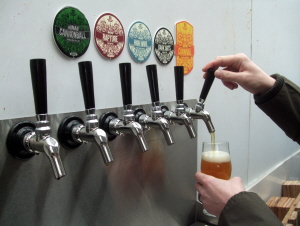 Beer taps at Magic Rock, Huddersfield. The interest in this format in the UK is increasing significantly – previously only one keg at Magic Rock might have been filled from a single brew, but now it’s closer to ten. Keykeg is also suitable for export, whereas the skills and equipment for handling cask are virtually unknown outside Britain. At present Magic Rock exports on a small scale to Norway but hopes to expand. “We expect the demand for keg is going to be massive in future,” predicts Stuart.
The sampling taps at the brewery only dispense keykeg beers and very good they are too. One of the highlights was Human Cannonball, the big brother of Cannonball, boosted not only with extra alcohol but with a whopping 25kg of hops in the hop back for every 20hl brew. This rich amber beer hits you with an aroma of lemon squash, melon and hay, with stewed hops so vivid you can almost see them steaming in the hop back. There’s a firm malty body with more melon fruit and obvious, though rounded, alcohol. Spicy pepper, pine and chilli-like notes dance on a warming finish, leaving a burry bitter slick that takes minutes to fade.
You’d expect a brewery like this to offer an imperial stout and they don’t disappoint with Bearded Lady, a development of a more approachable 6% stout called Dark Arts. I sampled it on keg at the Port Street Beer House in Manchester back in January, discovering a complex beer with a near-black colour, chocolate, carbon and some cakey malt on the aroma.
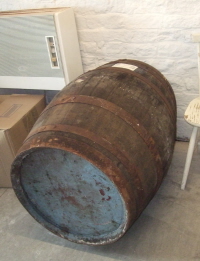 Refill barrel destined for Magic Rock beer at the brewery in Huddersfield. This too had a notably hoppy palate – with 10kg of hops in the hop back per brew, it’s some way behind Human Cannonball in the hop monster league, but the resinous cones made their presence felt alongside roast, minerals and tangy fruit. Overall, though, these vivid flavours were well integrated within a smooth and milky mouthfeel with not too much sweetness. The finish turned immediately tangy to the point of slight astringency, with emerging ashy flavours and fine dark chocolate.
Given the pervasive US influences, barrel ageing is a logical next step and sure enough Magic Rock is already experimenting, having acquired four refill barrels of various kinds. The first result is a version of Bearded Lady aged for six months in a former bourbon barrel and called, naturally enough, Bourbon Barrel Bearded Lady. This was eagerly anticipated during the beer bloggers’ visit, and a communal cry of anguish went up when it appeared the beer had run out after only a handful of glasses, followed by an even bigger sigh of relief when it turned out only to be a dispensing problem that was soon solved.
 Magic Rock Bourbon Barrel Bearded Lady This thick black beer had a spirity, brown sugar aroma with notes of sherry fruit cake and a sharpish black cherry yoghurt-like touch. A tingly, minty palate boated richly fruity, raisiny malt, followed by a massive development of chocolate flavour teased by Listerine-like phenols. The very long and toasty dry chocolate finish had shards of hops with generous sweetness and developing roast coffee character, with more raisin fruit – an impressive example of the style.
One criticism that could be levelled at Magic Rock is that they are just a little too slavish in their apeing of the US craft brewing model, but the desire to experiment opens up the opportunity to create beers in a really distinctive style, and there’s a Yorkshire groundedness about the operation that should help too. Definitely one to watch.
European Beer Bloggers Conference 2012
Top Tastings 2012
ABV: 6.8%
Origin: Manchester, England
Website: www.marblebeers.co.uk
A serious looking 750ml bottle from Manchester’s marvellous Marble brewery can usually be relied upon to contain something at least interesting, but they’ve excelled themselves with Marble Earl Grey IPA (6.8 per cent), a collaboration brew with Emelisse from the Netherlands. A robust US-style India pale ale with fresh and fruity Citra hops has been given extra layers of flavour by adding Earl Grey tea.
“It was like putting a giant teabag into the copper,” head brewer James Campbell told me at the 2012 European Beer Bloggers Conference in Leeds, where Earl Grey proved one of the hits of the live beer blogging session. I managed to persuade him to part with a leftover bottle, which drew equally enthusiastic reactions at a tasting I hosted a few weeks later at Mason & Taylor in London.
As tea aficionados will know, Earl Grey is a smoky black tea perfurmed with bergamot oil, derived from a highly fragrant citrus fruit (Citrus bergamia) used in perfumery as well as to flavour other products. It turns out to form a good match with this particular style of US-inspired IPA – tea and smoky flavours are not unknown in the beer flavour palate and the subtle hints of bergamot match well with the citrus fruit notes from the hops.
My samples poured a cloudy warm amber with a bit of foamy head. Bergamot was certainly detectable on the aroma alongside apricots and more familiar orange and lemon notes. The palate was very fruity – tropical fruits, apricot, a lemon tea-like character, some very subtle oily perfume from the bergamot and a pronounced but not excessive bitterness. The tasty finish had plenty of complexity, with a controlled and lingering bitterness, building tannins and a slightly boxy, musty note.
This was one of the most distinctive beers I’ve tasted all year, and though he planned it as a limited edition one-off, James hinted to me that as the reaction had been so strong he might consider brewing it again. Let’s hope so.
|
Cask  This pioneering new book explains what makes cask beer so special, and explores its past, present and future. Order now from CAMRA Books. Read more here. This pioneering new book explains what makes cask beer so special, and explores its past, present and future. Order now from CAMRA Books. Read more here.
London’s Best Beer  The fully updated 3rd edition of my essential award-winning guide to London’s vibrant beer scene is available now from CAMRA Books. Read more here. The fully updated 3rd edition of my essential award-winning guide to London’s vibrant beer scene is available now from CAMRA Books. Read more here.
|





















